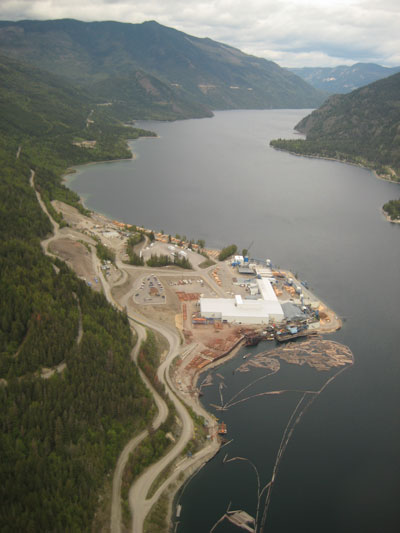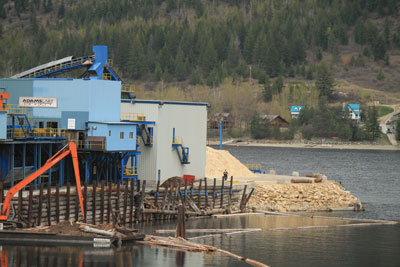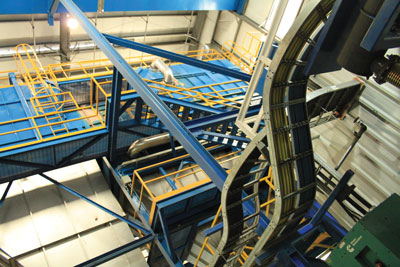
Sustainable Investment
August 13, 2012
By April Van Ert
When International Forest Products Ltd. (Interfor) decided to invest in the installation of a biomass-fired energy system at its Adams Lake Sawmill in British Columbia’s interior,
When International Forest Products Ltd. (Interfor) decided to invest in the installation of a biomass-fired energy system at its Adams Lake Sawmill in British Columbia’s interior, sustainability was certainly on the minds of Interfor’s management. But for them, sustainability went far beyond the environmental benefits of the investment.
 |
|
| Interfor’s Adams Lake sawmill installed a biomass-fired energy system, and also modified its existing lumber-drying kilns and space-heating systems. Photos: Interfor
|
“The investment coincided with the company’s master plan for modernizing the entire mill site,” says Ric Slaco, Vice President and Chief Forester for Interfor.
Interfor’s investment in switching to cleaner technologies involved not just installing a biomass-fired energy system, but also modifying its existing lumber-drying kilns and space-heating systems. The upgrades allow Interfor to use wood waste from the lumber manufacturing process to dry lumber and heat buildings during cold winter months.

|
|
| The biomass energy system at Adams Lake uses wood residue from its lumber manufacturing process as a fuel.
|
“Our investment at Adams Lake underscores Interfor’s ongoing commitment and confidence in the future of the forestry business in BC,” notes Slaco. He points out Interfor made a concerted effort to engage local suppliers while committing to growing the province’s low carbon economy. This fuel-switching project brought multiple benefits to the environment and supported the spread of cleaner technologies in BC.
By using wood residue from its lumber manufacturing process as a fuel, Interfor replaced liquefied natural gas – and its associated emissions – with wood. The key to cleaner air was an investment in sophisticated technology: the waste wood was combusted at extremely high heat in a highly-efficient energy system, with emissions control equipment that reduced particles in the air well below provincial standards. Today heat vapour is primarily all that drifts out of the mill’s thermal plant. While switching to a cleaner-burning fuel improved air quality in this important recreational and salmon-spawning region, it also diverted wood waste from landfills. To top it all off, Interfor purchased the technology from BC-based manufacturer of turnkey biomass installations Wellons Canada, further supporting the growth of the local green economy.
 |
|
| To date, the Interfor Adams Lake project has meant the avoidance of nearly 41,000 tonnes of carbon dioxide emissions. Photos: www.videonexus.ca
|
With the Adams Lake Mill providing all of its own fuel, Interfor was able to eliminate another expense and ongoing source of emissions: those from the weekly 750-kilometre round trip diesel truck journey needed to supply the mill with liquefied natural gas. As the consumption of 500 litres of diesel results in some 1.3 tonnes of emissions, cutting out this weekly trip from BC’s Lower Mainland to the interior of the province is of undeniable benefit to the environment.
“It was a feel-good project all around,” Slaco says, adding there was a “real sense of pride” when our employees saw Interfor was thinking about the future on so many fronts. Not only were we investing in equipment but in people as well. To ensure that the company had the expertise to effectively manage the new clean energy system it provided training for 15 employees to become Class 5 certified power engineers. Slaco says this additional training was integral to making sure the company had the expertise to manage the new clean energy systems.
Despite all the benefits of the project, implementing it was not a given because of the substantial capital investment it called for. The sale of carbon offsets was identified as one of the requirements to justify the investment. “The potential for receiving offsets were certainly considered as a factor in helping to decide to go ahead with the project,” says Slaco.
 |
|
| “The investment coincided with the company’s master plan for modernizing the entire mill site,” says Interfor’s Richard Slaco. Photo: Interfor
|
In 2007, the government of British Columbia made the bold decision to become carbon neutral and thereby provide the framework for a low carbon economy. A key component was the creation of Pacific Carbon Trust. Pacific Carbon Trust was established in 2008 to help companies, public sector organizations and individuals reduce their carbon emissions and usher in a new clean economy standard in the province. Pacific Carbon Trust both acts as a reliable provider of verified carbon offsets and facilitator for those seeking to implement a project.
“Pacific Carbon Trust has been instrumental in terms of moving British Columbia in this direction,” Slaco says. He highlights the rigorous accountability standards that anchor Pacific Carbon Trust’s decisions to proceed with offset projects. “We’re all paying close attention to how to implement the methodology,” he says, referring to the stringent process of ensuring that the switch to biomass did indeed constitute a verifiable reduction in carbon emissions. To date, the project has meant the avoidance of nearly 41,000 tonnes of carbon dioxide emissions through the switch to the cleaner burning, on-site fuel source in the form of wood waste.
For Slaco, Interfor’s involvement in this project also showcases unrecognized potential for innovation in the forestry sector. “I’m just glad to see that there is encouragement for companies either on their own or through initiatives like this to be moving forward with projects that demonstrate what we can do to provide quality products that are also good for the environment.”
| Biomass Fuel Switch (Interfor, Adams Lake) Interfor’s installation of a biomass-fired energy system and modifications to its lumber-drying kilns and space-heating systems have eliminated the use of liquefied natural gas at the site. The system is extremely efficient; the combustion process reaches 1,800°F. and is controlled precisely to allow for complete combustion. The resulting ash can be disposed of safely in landfill or used as fertilizer. Project Type: Fuel Switching |
Print this page